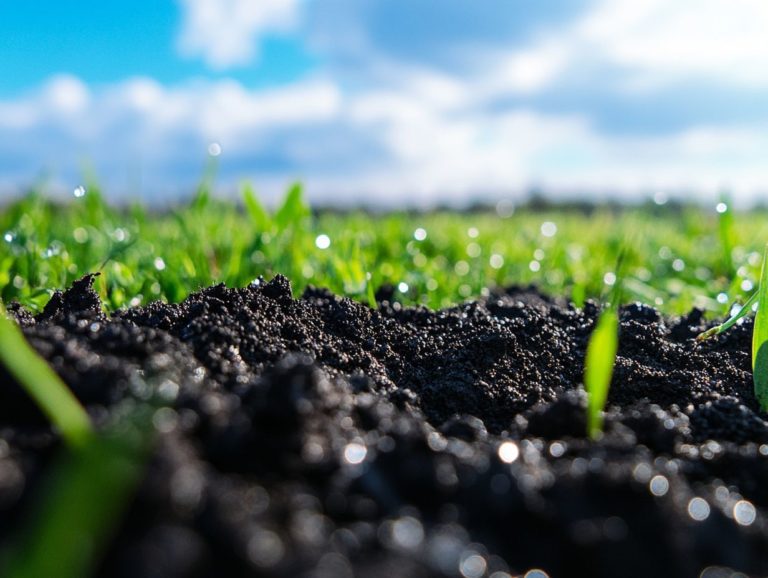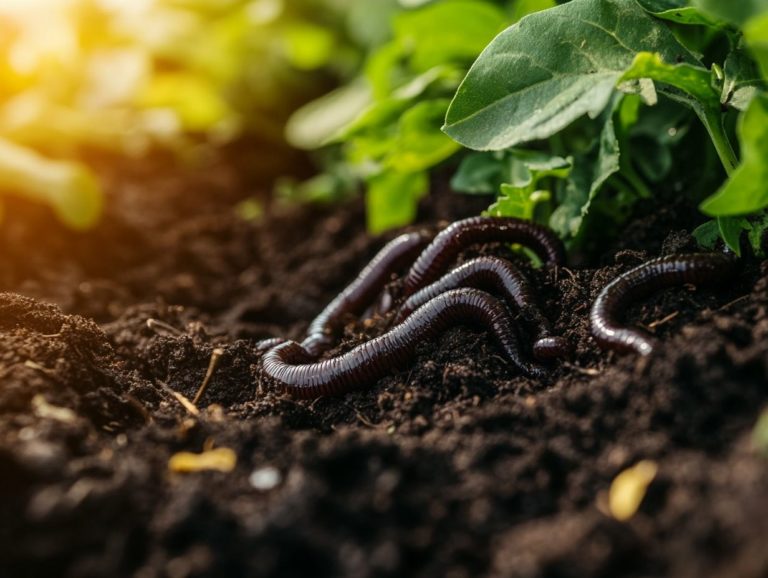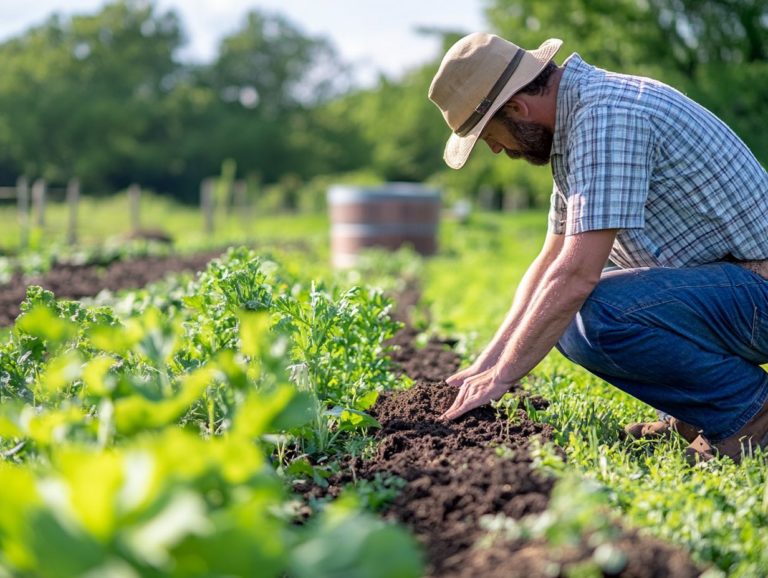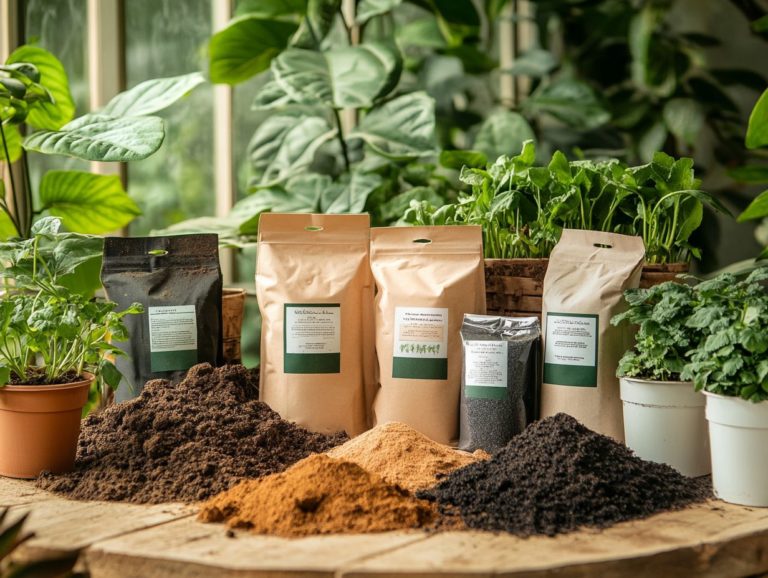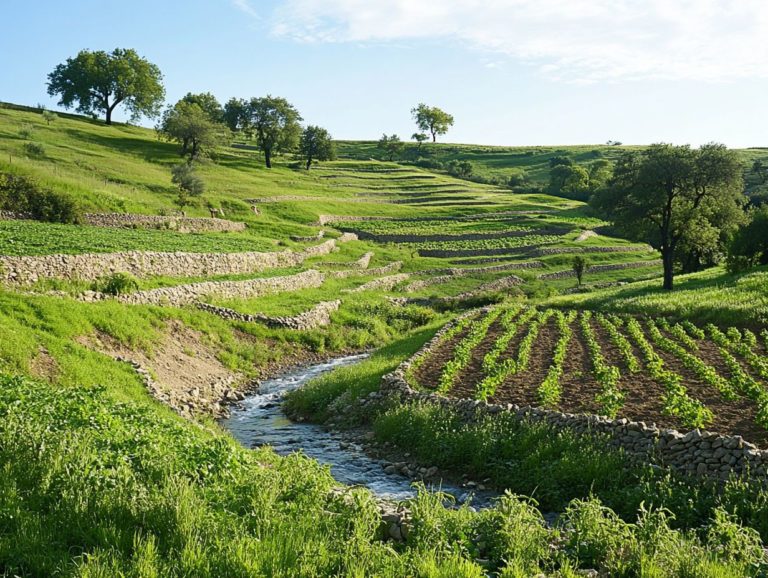5 Ways to Encourage Soil Biodiversity
Soil biodiversity serves as the foundation for robust ecosystems and sustainable agriculture. By nurturing a diverse array of organisms within the soil, you can significantly enhance the resilience of your crops, improve nutrient cycling, and manage pests naturally.
Get ready to explore five effective strategies for promoting soil biodiversity, ranging from planting a variety of crops to minimizing tillage. This article examines the benefits and consequences associated with soil biodiversity, dispels common myths, and provides practical tips for anyone eager to make a positive impact.
Immerse yourself in this exploration and discover how fostering healthy soil can lead to flourishing gardens and thriving farms.
Contents
Key Takeaways:
- Plant diverse crops for a healthier ecosystem.
- Natural fertilizers and pesticides support beneficial soil life.
- Crop rotation keeps soil rich and prevents pest issues.
1. Plant a Variety of Crops
As you step into the New Year, consider adopting one of the most impactful health resolutions for your farming practice: planting a diverse range of crops. This strategy not only enhances soil health but also promotes ecological balance, ultimately boosting food production and agricultural productivity.
This commitment elevates your crop yields and plays a crucial role in maintaining soil structure, which is essential for water retention and robust root development. Embracing crop diversity enriches nutrient cycling due to the varied root structures and organic matter that different plants contribute. It also helps prevent nutrient run-off and enhances crop nutrition.
For example, combining beans with grains can boost soil health while naturally deterring pests. Using cover crops like clover or radish significantly enhances microbial activity, fostering a resilient ecosystem that combats diseases and improves the sustainability of your farm.
2. Use Natural Fertilizers and Pesticides
Utilizing natural fertilizers and pesticides is crucial for your sustainable farming efforts. These practices enhance soil health and cultivate beneficial relationships with insects, reducing your reliance on harmful agrochemicals.
Incorporating organic fertilizers like compost into your soil management practices significantly improves soil structure and nutrient content, fostering a vibrant ecosystem that promotes robust plant growth. Natural pesticides, derived from ingredients such as neem or garlic, offer effective pest control while safeguarding beneficial organisms.
These methods help restore balance in the environment, counteracting the detrimental effects of chemical fertilizers that often lead to soil degradation and a decline in biodiversity. By addressing issues like agrochemical misuse, these eco-friendly approaches support your agricultural goals and contribute to a thriving planet for future generations.
3. Implement Crop Rotation
Implementing crop rotation is an essential practice in soil management that enhances nutrient availability and mitigates soil compaction, paving the way for healthier crops and sustainable farming systems. This technique effectively prevents biodiversity decline and improves the resilience of farming systems.
By regularly alternating different types of crops, you can break pest and disease cycles, improve soil fertility, and maintain a diverse microbial ecosystem. For instance, when you rotate legumes with grains, you naturally boost nitrogen levels in the soil, reducing the dependency on synthetic fertilizers.
Successful rotations such as planting corn after soybeans not only protect against erosion but also cultivate a more resilient agricultural landscape. This approach decreases reliance on agrochemicals, ultimately fostering both soil health and biodiversity.
Start implementing these strategies today and watch your soil thrive!
4. Create Habitats for Beneficial Organisms

Create habitats for beneficial organisms like earthworms and fungi that help plants grow. This boosts soil microbial activity, supports biodiversity, and leads to healthier crops while incorporating 5 ways to encourage water infiltration.
These organisms play a key role in nutrient cycling. They break down organic matter and release essential nutrients that plants can easily absorb.
You can establish these habitats by planting cover crops during the off-season. This protects the soil from erosion and provides food and shelter for these vital organisms.
Reducing chemical interference by minimizing pesticides and herbicides enables these beneficial inhabitants to thrive. This optimizes the overall health of the ecosystem and supports sustainable agricultural practices.
5. Reduce Tillage
Reducing tillage operations is a sustainable practice that significantly enhances soil structure and water retention. It decreases soil compaction, resulting in healthier farming systems.
This approach preserves organic matter, essential for supporting crop growth and sustaining microbial life within the soil ecosystem. By minimizing disruption, soil organisms thrive, promoting biodiversity and overall soil health.
To further elevate your farming practices, consider integrating alternative techniques such as cover cropping and crop rotation. These strategies maintain soil integrity and significantly boost agricultural productivity!
- Preventing erosion
- Improving nutrient cycling
- Reducing dependency on chemical fertilizers
Ultimately, these methods cultivate resilient farming ecosystems that can withstand environmental stresses, enhance food security, and promote healthy plants that thrive despite challenges posed by human activity.
How Does Soil Biodiversity Impact Agriculture?
Soil biodiversity plays a crucial role in agriculture, influencing ecosystem functions and enhancing nutrient cycling. This bolsters the resilience of farming systems against climate change and human activity.
A diverse array of organisms, including bacteria, fungi, and earthworms, is integral to maintaining soil health. Microorganisms break down organic matter to release essential nutrients like nitrogen and phosphorus nutrients vital for your plants’ growth.
Beneficial fungi establish symbiotic relationships with plant roots, improving their water uptake and nutrient absorption. Healthy soils directly correlate with increased crop yields. Research indicates that farms with rich microbial diversity produce more vigorous plants and show greater resistance to pests and diseases.
This dynamic interplay enhances food security by improving the productivity and sustainability of agricultural systems essential for feeding the ever-expanding global population.
What Are the Benefits of Encouraging Soil Biodiversity?
Encouraging soil biodiversity brings a wealth of benefits, such as enhanced soil health and boosted agricultural productivity. To further improve soil quality, consider exploring 5 ways to improve soil organic content, which can lead to the growth of stronger plants that can withstand pests and diseases.
This holistic approach improves nutrient cycling and nurtures a vibrant ecosystem where diverse microorganisms work together to decompose organic matter. A case study from the Midwest revealed that farms embracing cover cropping and reduced tillage saw a remarkable surge in beneficial microbial populations, resulting in a 20% increase in crop yields over three years.
Further research from the Rodale Institute shows that regenerative practices focusing on soil biodiversity enhance water retention and minimize chemical inputs. This reduces costs for farmers and positively impacts the environment, making sustainable agriculture an attractive choice for generations to come.
What Are the Consequences of Poor Soil Biodiversity?

Poor soil biodiversity can lead to serious consequences that impact your environment and food security. Soil degradation, increased vulnerability to climate change, and the effects of human activity may become more pronounced.
These challenges often worsen due to practices like excessive agrochemical use and monocropping. These practices deplete essential nutrients and disrupt the intricate web of organisms thriving beneath the surface. For example, the Midwest of the United States, which heavily depends on corn and soybean monocultures, has seen a significant decline in soil health, leading to a staggering 50% reduction in microbial diversity.
This loss directly affects crop resilience. It makes farmland more vulnerable to pests and diseases, ultimately jeopardizing farmers’ livelihoods and the stability of food systems globally. Farmers need to adopt practices that counteract biodiversity decline to secure their production levels.
How Can Farmers and Gardeners Promote Soil Biodiversity?
You can easily boost soil biodiversity through a range of effective practices, including compost application, crop rotation, and following 5 ways to reduce soil pollution by creating planting beds that nurture diverse ecosystems.
To elevate soil health, consider incorporating organic fertilizers. They not only supply essential nutrients but also bolster the microbial community that thrives beneath the surface.
Creating habitats for beneficial soil organisms, like earthworms and tiny worms that help improve soil health, is another key step. Achieve this by leaving certain areas of your garden undisturbed or by planting cover crops during the off-season. This approach encourages natural processes that enrich your soil.
Regular soil testing is vital as well. It helps you identify nutrient deficiencies and allows you to implement tailored interventions that support a balanced ecosystem.
By adopting these strategies, you’ll cultivate a more resilient and productive environment for your gardening or farming endeavors.
What Are Some Common Myths About Soil Biodiversity?
You may have encountered several myths regarding soil biodiversity, such as the misguided belief that chemical fertilizers are essential or that monocropping is the most efficient farming method.
A closer look at scientific studies reveals a different story: over-reliance on chemical inputs can degrade soil health and disrupt natural ecosystems. For example, organic farming practices have been shown to boost microbial diversity the variety of microorganisms in the soil that are crucial for nutrient cycling and enhance soil structure, leading to healthier crops.
Implementing crop rotation and polyculture can further enhance resilience against pests and diseases. Diverse agricultural practices offer more sustainable solutions. By embracing a variety of farming techniques, you not only contribute to thriving ecosystems, but you also safeguard your long-term success in an ever-changing climate.
How Can Individuals Help Support Soil Biodiversity?
You play a crucial role in supporting soil biodiversity by embracing sustainable practices such as composting, planting native species, and educating yourself and others about the significance of healthy soils.
These efforts enrich the very ground you walk on and contribute to a more resilient ecosystem. By engaging in community initiatives, you can lead workshops to teach your neighbors effective techniques for nurturing their gardens.
Together, you and your community can organize local clean-up days or tree planting events, significantly enhancing soil quality and biodiversity in your neighborhoods. It s truly remarkable how individual actions, when combined, can lead to substantial improvements in food security, ensuring everyone has access to nutritious, locally grown produce.
By fostering a spirit of collective action, you and your community can create a robust support network dedicated to protecting and revitalizing the soil that sustains us all.
Frequently Asked Questions

What is Soil Biodiversity and Why is it Important?
Soil biodiversity means the variety of living organisms in the soil, including bacteria, fungi, insects, and worms. It s vital for keeping soil healthy and fertile, which supports plant and animal life.
How to Encourage Soil Biodiversity
- Avoid chemical fertilizers and pesticides. They harm beneficial organisms and upset the soil s natural balance.
- Practice crop rotation. This means changing the types of crops you grow each season to keep the soil rich in nutrients.
- Use mulch and compost. These organic materials feed soil organisms and help retain moisture.
- Plant a variety of crops. Different plants attract different soil organisms, boosting biodiversity.
- Leave some areas of your garden undisturbed. This creates habitats where soil organisms can thrive.
Benefits of Soil Biodiversity for Plants
Soil organisms help break down organic matter and release nutrients essential for plant growth. They also improve soil structure, enhancing its ability to hold water and nutrients, leading to healthier plants.
Risks of Poor Soil Biodiversity
When soil lacks biodiversity, it can lose fertility. This leads to lower crop yields, poor plant health, and increased vulnerability to diseases and pests.
Increasing Soil Biodiversity in Urban Areas
Yes, you can boost soil biodiversity in cities! Use compost, practice responsible gardening, and add green spaces with native plants in urban designs.
Timeline for Results from Encouraging Soil Biodiversity
Results from encouraging soil biodiversity vary based on soil health and practices. Generally, expect to see noticeable improvements in several months to a few years.
Start today! Your garden and the planet will thrive!

